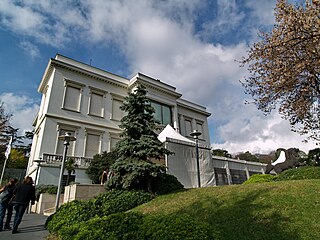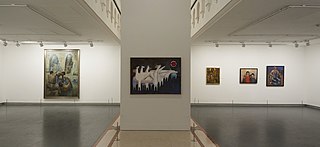
The Emirate of Sharjah is one of the emirates of the United Arab Emirates, which covers 2,590 square kilometres (1,000 sq mi) and has a population of over 1,400,000 (2015). It comprises the capital city of Sharjah, after which it is named, and other minor towns and exclaves such as Kalba', Al Dhaid, Dibba Al-Hisn and Khor Fakkan.

The Sabancı University Sakıp Sabancı Museum is a private fine arts museum in Istanbul, Turkey, dedicated to calligraphic art, religious and state documents, as well as paintings of the Ottoman era. The museum was founded by Sakıp Sabancı, and was opened in June 2002. Aside from permanent exhibitions, the museum also hosts national and foreign temporary exhibitions and, hosts cultural events on the weekends.

The Museum of Anatolian Civilizations is located on the south side of Ankara Castle in the Atpazarı area in Ankara, Turkey. It consists of the old Ottoman Mahmut Paşa bazaar storage building, and the Kurşunlu Han. Because of Atatürk's desire to establish a Hittite museum, the buildings were bought upon the suggestion of Hamit Zübeyir Koşay, who was then Culture Minister, to the National Education Minister, Saffet Arıkan. After the remodelling and repairs were completed (1938–1968), the building was opened to the public as the Ankara Archaeological Museum.

In some forms of Islamic art, aniconism (the avoidance of images of sentient beings) stems in part from the prohibition of idolatry and in part from the belief that the creation of living forms is God's prerogative.

The Istanbul Archaeology Museums are a group of three archaeological museums located in the Eminönü quarter of Istanbul, Turkey, near Gülhane Park and Topkapı Palace.

The Museum of Islamic Art (MIA) in Cairo, Egypt is considered one of the greatest museums in the world, with its exceptional collection of rare woodwork and plaster artefacts, as well as metal, ceramic, glass, crystal, and textile objects of all periods, from all over the Islamic world.

The Turkish and Islamic Arts Museum is a museum located in Sultanahmet Square in Fatih district of Istanbul, Turkey. Constructed in 1524, the building was formerly the palace of Pargalı Ibrahim Pasha, who was the second grand vizier to Suleiman the Magnificent, and was once thought to have been the husband of the Sultan's sister, Hatice Sultan.

The Department of Asia in the British Museum holds one of the largest collections of historical objects from Asia. These collections comprise over 75,000 objects covering the material culture of the Asian continent, and dating from the Neolithic age up to the present day.

The Antalya Museum or Antalya Archeological Museum is one of Turkey's largest museums, located in Konyaaltı, Antalya. It includes 13 exhibition halls and an open air gallery. It covers an area of 7,000 m2 (75,000 sq ft) and 5000 works of art are exhibited. In addition a further 25,000–30,000 artifacts which cannot be displayed are in storage. As a museum exhibiting examples of works, which illuminate the history of the Mediterranean and Pamphylia regions in Anatolia, Antalya Museum is one of the most important of Turkey's museums. The Museum won the "European Council Special Prize" in 1988.

Sharjah is the third-most populous city in the United Arab Emirates, after Dubai and Abu Dhabi. It is the capital of the Emirate of Sharjah and forms part of the Dubai-Sharjah-Ajman metropolitan area.

The National Museum of Saudi Arabia is a national museum located in the al-Murabba neighborhood of Riyadh, Saudi Arabia. Established in 1999, it is part of the King Abdulaziz Historical Centre and is surrounded by al-Wadi Park to the north and al-Madi Park to the east, who altogether constitute eastern side of the National Museum Park.

The Sharjah Museums Authority (SMA), formerly named Sharjah Museums Department (SMD), is a government agency in Sharjah, United Arab Emirates.

The Sharjah Art Museum is an art museum in the city of Sharjah, United Arab Emirates. It was housed in Bait Al Serkal in Al Shuwaihean Area. It is one of the leading art institutions in the Persian Gulf region.

Ibrahim Bin Yousuf Al Hasan Al Fakhro is a Qatari writer, businessman and art collector. He authored a book entitled “Arabic Calligraphy and Quran, A shared journey” in 2015. He also held several exhibitions regarding Arabic calligraphy, Islamic Art, and the life of Muhammad. He is currently vice-chairman of the Middle East Facility Management Association.
Amasya Museum, also known as Archaeological Museum of Amasya, is a national museum in Amasya, northern Turkey, exhibiting archaeological artifacts found in and around the city as well as ethnographic items related to the region's history of cultural life. Established in 1958, the museum owns nearly twenty-four thousand items for exhibition belonging to eleven historic civilizations.

Barjeel Art Foundation is a non-profit arts organisation based in Sharjah, United Arab Emirates. The foundation was established in 2010 by Emirati commentator Sultan Sooud Al Qassemi to manage and exhibit his personal art collection. There are over 1,000 pieces of modern and contemporary art in the foundation's art collection. The organisation primarily focuses on artwork produced by Arab artists worldwide and includes paintings, sculptures and installations.
Mouneer Al-Shaarani is a Syrian graphic artist specialized in Arabic calligraphy. Al-Shaarani is known as calligrapher, graphic designer and author of articles about Arabic calligraphy and Arab Islamic art. He has designed several Arabic typefaces for book covers or other graphic creations. His work has been exhibited in several Arab countries, Malaysia, Europe, Australia and the United States and is internationally presented in collections of contemporary Arabic art. Between 1985 and 2007, he lived and worked in Cairo, Egypt, and later returned to live in Damascus.

The Nasser D. Khalili Collection of Islamic Art includes 28,000 objects documenting Islamic art over a period of almost 1400 years, from 700 AD to the end of the twentieth century. It is the largest of the Khalili Collections: eight collections assembled, conserved, published and exhibited by the British-Iranian scholar, collector and philanthropist Nasser David Khalili, each of which is considered among the most important in its field. Khalili's collection is one of the most comprehensive Islamic art collections in the world and the largest in private hands.



















